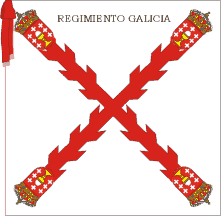It is nearly the official birthday of the monarch, a day when the Guardsmen of the army perform one of the oldest military ceremonies in the world. One of the five regiments of Foot Guards troop their colour, in what is a fantastic display of colour, music and military drill.
What are colours?
The modern flag of today has its origins on the battlefield. The earliest forerunners of flags came from men (and women in some cases) wishing to display a symbol in a battle that represented either themselves, clan or tribe. In the middle ages knights, lords, barons and kings displayed their arms on a flag by way of a banner or heraldic standard or both. The closest link we have today of the earliest origins of Vexillology or flags to the layperson is probably the military colour, although often now only used for ceremonial parades rather than in battle.
Ceremony at Windsor Castle in 2009 where 1st Battalion, Irish Guards received their current colours
Brief History
Most historians would agree that the Romans were the first to have an organised standing army, rather than a feudal style army more common of the time. As such they are regarded as the first military ever where each unit had a permanent standard. From about 104BC to the collapse of the empire each legion carried an Aquila (or eagle) as its standard symbol. This wasn't exactly a flag or banner but a gold coloured eagle on a pole, rather than a unit symbol this was probably more of a national symbol like a national flag. Pikes with sculptures of the Emperor were also used alongside the eagle.
Perhaps the Roman equivalent of a regimental or company colour is the vexillum or signum. This had the legion number and symbol on it, and was unique to the individual legion.
Roman soldiers being led by the Eagle and Vexillum
The eagle was however the most precious, the loss of an eagle was a dishonour and disgrace which often led to the disbandment of the legion if it couldn't be recovered. The regard of the eagle is possibly best described in the story of the Roman invasion of Britain. Julius Caesar's Tenth Legion hesitated leaving their boat fearing the native Britons. So the officer in charge of the eagle called an auilifer carrying the eagle charged the Britons alone knowing that his men would follow to save their eagle and themselves from disgrace which according to the story they did. The idea of the eagle became a legend in itself, the French Emperor Napoleon Bonaparte (who fancied himself as Caesar) personally gave each regiment a flag with a bronze imperial eagle on top of the staff. The French eagle was treated the exact same way as a Roman one and as such to capture one was a source of immense individual and regimental pride, The Royal Scots Dragoon Guards even feature an eagle in their cap badge to commemorate one captured at Waterloo, and officers of the Royal Irish Regiment, wear an eagle on their crossbelt to commemorate one they captured in the Peninsular War.

Sgt Masterson of 87th Regiment of Foot (Royal Irish Fusiliers) capturing a French Eagle Battle of Barossa 1811.
However with the collapse of the Roman Empire, Europe basically had to start over again from scratch. medieval heraldry picked up where the Romans left off. However the big difference between the medieval Kingdoms and the Roman Empire, was that unlike Rome there was no standing army or organised military.
However with the emergence of heraldry in medieval Europe heraldic flags such as banners and standards were carried into battle. As nobles normally raised and led companies in times of war, the heraldic banner or standard, could be seen as a way of identifying units on a battlefield, (by identify their leader). Likewise as unlike the modern military these flags were the flags of the commander rather than the unit, the standard bearer would often be close to the individual to whom it belonged. This is possibly the start of military colours not only marking where the unit was but also the exact position of the commanding officer and his staff on the battle field and parade ground, this helped the commander to easily rally his troops if necessary.
Robert I (the Bruce) King of Scots, Battle of Bannockburn 1314, this painting depicts excellently the use of heraldic banners
This was the case until the late 16th and 17th Centuries when armies started adopting the structure of regiments, and companies, and along with it Battle flags,
It was probably the Spanish army who first divided their soldiers into companies, each with its own flag. These flags were still used to mark out the commanding officer, to allow him to rally his troops more easily.
When companies were organised into regiments the design on the flags became more uniformed to represent the regiment but with subtle differences for each company. Although the flags themselves still denoted the presence of certain officers rather than their units. For example the colours of the Coldstream Guards in 1685 were as follows:
Hopefully this was before the white flag was associated with surrender! At this stage regiments were still raised and disbanded as and when needed by the nobility, so regimental colours (like the uniform) often differed from regiment to regiment, however they often followed a similar pattern. English regiments had a variety of colours, patterns and symbols but often had the cross of St George in the canton, during the English Civil War this pattern seems to have been used by both sides:
Later on the colours of English and Irish Regiments of this period come in all shapes and sizes but seem to generally feature a St George's Cross on a coloured field, with each regiment having a different colour. This could be the origin of the name colour. The practice of each company in a regiment carrying a flag was also dropped, with only the companies commanded by the four most senior officers carrying that officer's respective colour.
Replica of regimental flag of Dillon's (Irish) Regiment, Royal Army of France, War of the Grand Alliance 1688-97
Scottish colours at this time appear to follow a Variety of different patterns, some appear to follow the English pattern, while others uses Saltires (a different colour scheme for each regiment), while most still appear to be based on heraldry of their commander. The saltire does not strictly speaking follow the modern pattern of St Andrew's Cross of white cross on a blue field, but a variety of colours and patterns, however a blue field seems to have been favoured by the lowlanders. There are also examples of the
Scottish red ensign being used by Scottish regiments in European armies particulary Nordic ones:
French regiments appear to follow a similar pattern to English except with a white cross rather than a red one, the flur de lee was also common on French colours:
Spanish regiments carried a Cross of Burgundy and a unique regimental flag, later this changed to a Cross of Burgundy with the regiment's coat of arms in the coroners and a flag with the royal coat of arms in the centre.
|
| Regimental colour of Regiment Galicia 1734 (Spain) |
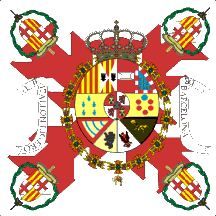 |
| King's Colour Barcelona Light Infantry 1810 |
However there are numerous examples of regiments not following these patterns in colours, so while these practises were common place they were by no means the standard official practice.
After the Union of England and Scotland in 1707 and the adoption of the Union Flag and the new national flag of the new Kingdom of Great Britain, very little changed in the use of colours. Initially four company colours were used. This was quickly replaced with each battalion carrying colours.
 |
Regimental colour British Army 18th Century, note Union flag canton
and regimental number and national flowers wreath,
the colour is the same as the regiment's uniform facings |
Like the UK Army today these consisted of two flags for each battalion, A King's Colour (or Queen's Colour if the monarch was of the fairer sex) and a Battalion or Regimental Colour. Since 1743 these followed a strict uniformed pattern, the regulations stated that colonels could not display their coat of arms or any personal heraldic device on their regiments colours. The King's Colour was established as a Union Flag, normally with the St George Cross defaced with a royal cypher and crown. The regimental colour was the same colour as the facings of the units uniform. It had a (representation) of the Union Flag in the canton, The Regiment's number (often in roman numerals) appeared in the center of this flag inside a wreath of roses, thistles and shamrocks. Although there were certain exceptions where a regimental insignia or badge was used instead.
Following the Napoleonic Wars, the colours started to become more elaborate, with more and more regiments displaying their battle honours on their regimental colours. Initially these were special badges with scrolls, however this system was soon replaced with scrolls only.
The first regiment in the British Army to be awarded a battle honour was the 18th (Royal Irish) Regiment, which displayed the motto "Virtutis Namurcensis Praemium" (The reward of virtue at Namur), which was awarded after the regiment distinguished itself at the siege of Namur in 1695. It also bore the Lion of Nassau in the corners, from the arms of King William III (Prince of Orange), in recognition of their loyalty during the williamite campaign in Ireland.
However they remained a practical piece of equipment for identifying regiments and as rallying points. After the 1860s regiments were known by name only, and so the practice of displaying the regimental number on the colour was phased out, and replaced with a regimental badge, during the 20th Century the Union flag canton was also dropped leaving the modern design, which is common throughout the Commonwealth.
 |
Modern British Army Queen's Colour. A Union Flag with regiment's full name in the centre
Note battalion number in canton and battle honours on St George's Cross |
 |
| Modern Regimental colour British Army, with regimental badge in centre, note battalion number in canton and battle honours, the oldest are badges the rest are in a wreath of scrolls |
Cavalry flags
 |
| 2nd Guidon 5th (Royal Irish) Dragoons 1751 |
Regulations on the flags of mounted units were introduced in 1743 (and amended in 1751) stated that calvary standards should be of damask, embroidered and fringed with gold or silver, those of dragoon regiments were made of silk. A Cavalry regiment had square standards where dragoons had swallow tailed guidons. Each regiment bore three standards the 1st the King's (or Colonels) standard was carried by the right flank squadron. This was crimson with a floral representation of the Union of Great Britain an entwined thistle and rose (a shamrock was also on some and on all after 1800) in the centre; beneath which was the royal motto "Dieu et mon Droit" (God and my right). on the first and fourth corners was the white horse of the Hanoverians, the arms of the royal dynasty ruling Great Britain & Ireland at the time. The number of the regiment in gold or silver numerals on the colour of the regiment's uniform facings were on the second and third.
the second or Lieut-Colonels guidon and third or majors guidons were the colour of the regiments facings. The second flag was carried by the left flank squadron and the third by the centre squadron. In the centre often (but not always) on a crimson disc surrounded by thistles, roses and shamrocks was either the regiment badge or its number. the white horse emblem was on the first and fourth corners and the entwined flowers on the second and third. The third guidon was distinguished from the second by a number "3" below the central emblem.
While most modern regiments who follow the cavalry tradition now only have one standard or guidon, the Household Cavalry still continue this practice.
Both of the historic branches the Life Guards and Blues & Royals carry a Sovereign's standards and three squadron standards, with the Blues & Royals carrying an additional Guidon due to being part dragoons.
The Sovereign's Standard is a red (gules) flag with a variant of the Royal coat of arms flanked by the letters "EII R." Below this are battle honours and citations. The Sovereign's Standard is normally only seen on State occasions like Trooping the Colour and the State Opening of Parliament as its only used when escorting the monarch or other member of the Royal Family.
The squadron Standards feature an entwined Tudor rose, thistle and shamrock (as such they are called Union Standards) flanked by a Crowned E and R, again below which are the battle honours interestingly there is no distinguishing markings for squadrons. The Blues & Royals Guidon features the Royal Cypher inside a garter belt topped with crown, within a wreath of roses, thistles and shamrocks, and is flanked by battle honours on scrolls. In the first and fourth corners is the hanoverian horse, the royal crest inside a garter belt in the second and an interpretation of a Napoleonic eagle in the third.
 |
| All the standards and guidon of the Blues & Royals on parade |
Rifle Regiments
Rifle regiments take their name from the weapons they used when the rest of the army used smooth bore muskets, they were skirmishers and sharpshooters, and wore green rather than red or blue as an early form of camouflage. As such it was impractical to carry colours so Rifle regiments don't carry colours to this day. They were known however to carry small flags and pennants for signaling and recognition, but these flags had no special meaning or value and were mostly unofficial.
2nd Battalion of the Royal Gurkha Rifles are no exception to this, however they do carry a special ceremonial staff called the "Queen's Truncheon" which is treated as the battalion colour. Originally awarded to Sirmoor Gorhka Battalion for loyalty in the Indian Mutiny, it is still used by the battalions successor 2 Gurkhas, made of Bronze and silver it has an artistic top representing Dehli Palace and Gurkha soldiers supporting the crown. A rare example perhaps of a modern vexilloid.
 |
| Truncheon Party of 2nd Gurkha Rifles. As Rifle Regiments don't carry colours this staff is treated as the colour, and is unique to 2 Gurkhas |
Brigade of Foot Guards
The five regiments of foot Guards famous for their drill, discipline and scarlet tunics and bearskin caps, have a variety of colours. These can be split into four categories:
Personal Colours
Due to the many ceremonial roles that these regiments perform, and royal personalities in the regiments (The Queen is Colonel in Chief of all Guard Regiments and many also have Royal colonels in addition). These flags are small pennants mesuring 1ft 8in x 1ft borne by a Non-Commissioned Officer (NCO) like a sergeant and are only used if the personality is present. When they are used they flank a saluting dias.
 |
TRH the Baron and Baroness of Carrickfergus on a saluting dias
and personal colours of the Irish Guards who's colonel is Prince William. |
Company Colours
Most regiments dropped company colours in favour of battalion colours, this is also true of the Guards, however the company colours have survived to a lesser extent, as Guard Companies are uniquely granted an individual badge by the sovereign. These badges are displayed on the colours and signs within barracks. The terminology for these flags differ depending on regiment, in the Irish Guards and Welsh Guards they are known as company colours, The Scots Guards simply call them flags, The Grenadier Guards call them Camp Colours, where the Coldstream Guards call them Silks. These flags are similar to the personal colours, although the Welsh Guards have a unique design based on the heraldic standard of Henry Tudor. An elongated flag, with a swallow tail, bearing dragons on a green and white field. In the hoist is a heraldic design associated with the Royal Family or Wales. The Company number in roman numerals is also depicted. On Parade the colours are used as marker points for the respective company, only the flags of companies on parade are used and are born by an NCO. While these flags do command respect, they are not treated with the same importance as the regimental colours.
 |
Company Colour of No1 Coy Welsh Guards. The Welsh Guards Company colours are
probably my favourite flags in the British Army. |
Regimental Colours
Like all other infantry battalion (except rifles as already mentioned) a Guards battalion caries two colours, a Queen's Colour and Regimental Colour. Like the line infantry this consists of a Union Flag and a flag the colour of old uniform facings. Unlike the line infantry the Queen's Colour is Crimson with a Royal insignia and the Regimental colour is a Union Jack, usually with a badge of one of the companies in the battalion in the centre (the company badges are born in rotation, so when new colours are presented a new badge takes its turn).
 |
Coldstream Guards Colour Party. The Union Flag is on the party's left (right of picture)
Because the Queen's Colour is actually the crimson flag |
The same battle honours are born on both colours, where as normally all the honours from the World Wars and conflicts since are born on one flag and older battle honours on the other. A reminder that while these soldiers often take part in ceremonies and state occasions they are professional soldiers who have and do serve all over the world.
State Colours
The last type of flag carried by the Foot Guards is the State Colour. Only the three most senior regiments (Grenadier Guards, Coldstream Guards and Scots Guards) have one. This is the largest type of colour in the army, and is only used on grand state occasions, such as the opening of parliament or when providing an honour guard for a visiting head of state. These flags are crimson with a regimental badge in the centre and royal insignia of the nations of Britain in the corners. This flag is used by itself and is only lowered for the monarch.
 |
| State Colour of the Grenadier Guards |
Artillery Guns
Traditionally the Royal Artillery honor their guns, and as such do not carry colours, the lead gun in a procession is treated as the colour. This is noted in trooping the colour when officers salute the lead gun of the king's Troop when riding past it. The only artillery unit to carry colours is the
Honourable Artillery Company which is not part of the Royal Artillery.
Royal Navy
Individual ship's companies of the Navy do not use colours for ceremonies, however the Royal Navy and Navy Reserve both have a Queen's Colour for such occasions. Both these are the variants of the Navy's white ensign, (the flag flown on RN ships) in the form of a ceremonial flag, defaced with a Royal Cypher in a garter belt.
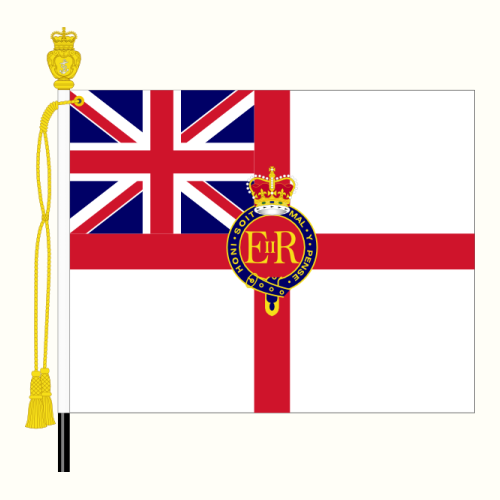 |
| Queen's Colour of the Royal Navy |
Likewise the Royal Fleet Auxiliary (RFA) the branch of the Merchant Navy who operate the military's supply ships, have a Queen's Colour like their naval colleagues this is a variant of the ensign flown on their ships defaced with a royal cypher:
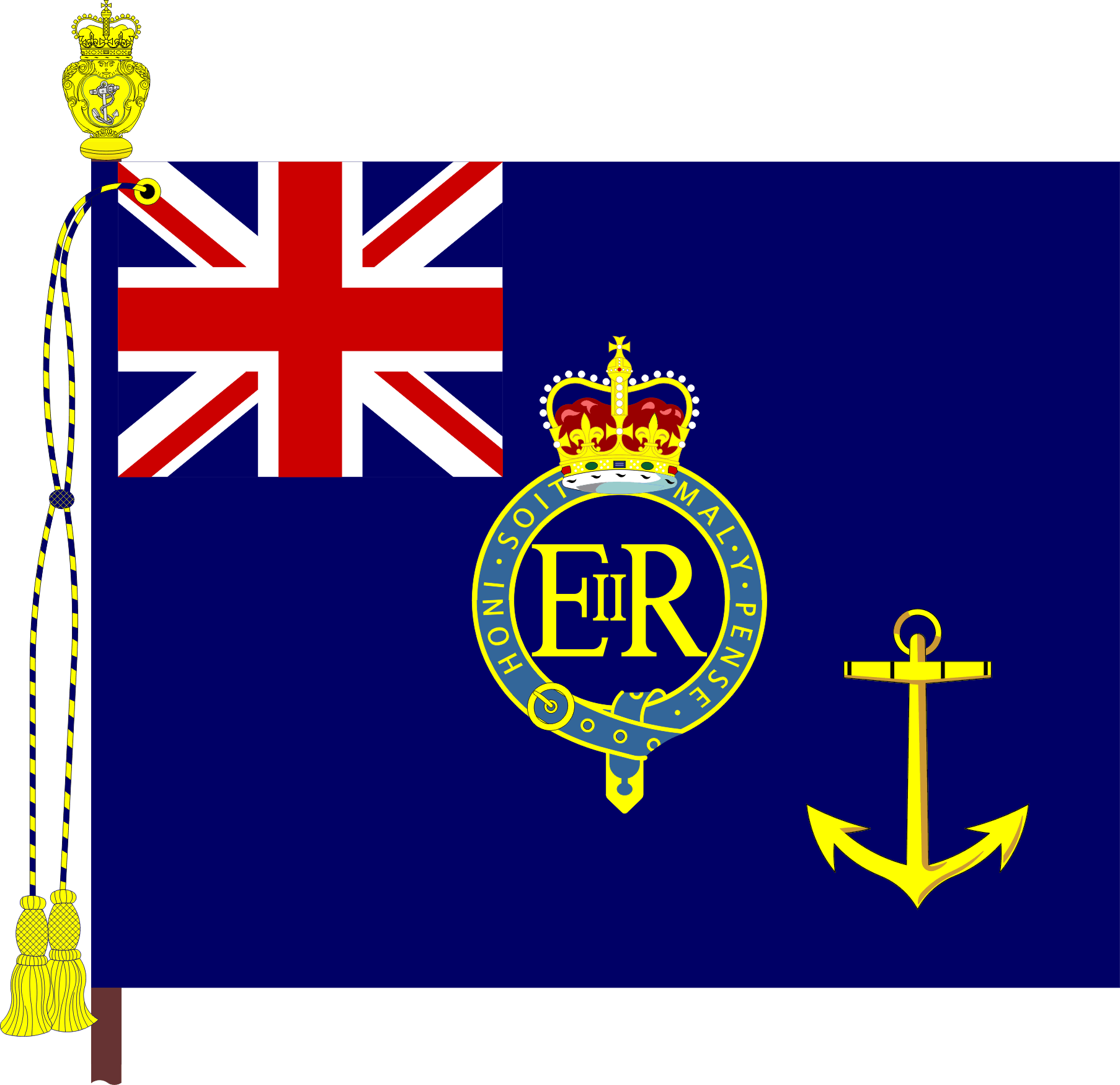 |
| Queen's Colour of the Royal Fleet Auxiliary |
The Commando Brigades carry colours in a similar way to army infantry battalions. A Queen's Colour in the form of a Union Jack, defaced with a variant of the Marine badge, but with the anchor between the globe and crown flanked with the letters "ER":
 |
| Typical Royal Marines Queen's Colour |
The Regimental colour is a blue ensign with the same design of insignia in the centre, but with the brigade number below it, and the royal cypher in the remaining three corners.
 |
| Regimental colour of 40 Commando Royal Marines |
Royal Air Force
Like the Naval Service the Air Force has its own Queen's Colour which is also a variant of its ensign in the form of a ceremonial flag defaced with a royal cypher.
 |
| Queen's Colour of the Royal Air Force |
Unlike the Naval Service however; the RAF has individual colours for units, these are called squadron standards. The Squadron standard is a sky blue flag, with a beautiful border of roses, thistles, leeks and shamrocks, in the centre is the squadron badge, around which are its battle honours.
 |
Typical RAF Squadron Standard, note the floral boarder, and squadron badge in the centre,
flanked by battle honours |
Both types of flags are used individually on ceremonial occasions.
Other Nations
The colours of the United States Army is similar to those of commonwealth realm armies. There is a national colour and organisational colour. The national colour is as the name suggests an American flag, and the equivalent of the Queen's Colour, the organisational colour being the equivalent of the regimental colour. The organisation colour is a single colour which represents the branch the unit is from, each branch also has fringe colour, which is the colour of the decorative trimming on the flag. The standard design of this flag features the eagle from the USA Great Seal, however the shield bears the unit coat of arms and the scroll in the eagles mouth the motto. A scroll underneath the eagle will have the unit name. Unlike British colours Americans don't display battle honours on the flag itself, instead honours and citations are displayed on streamers and flyers attached to the staff.
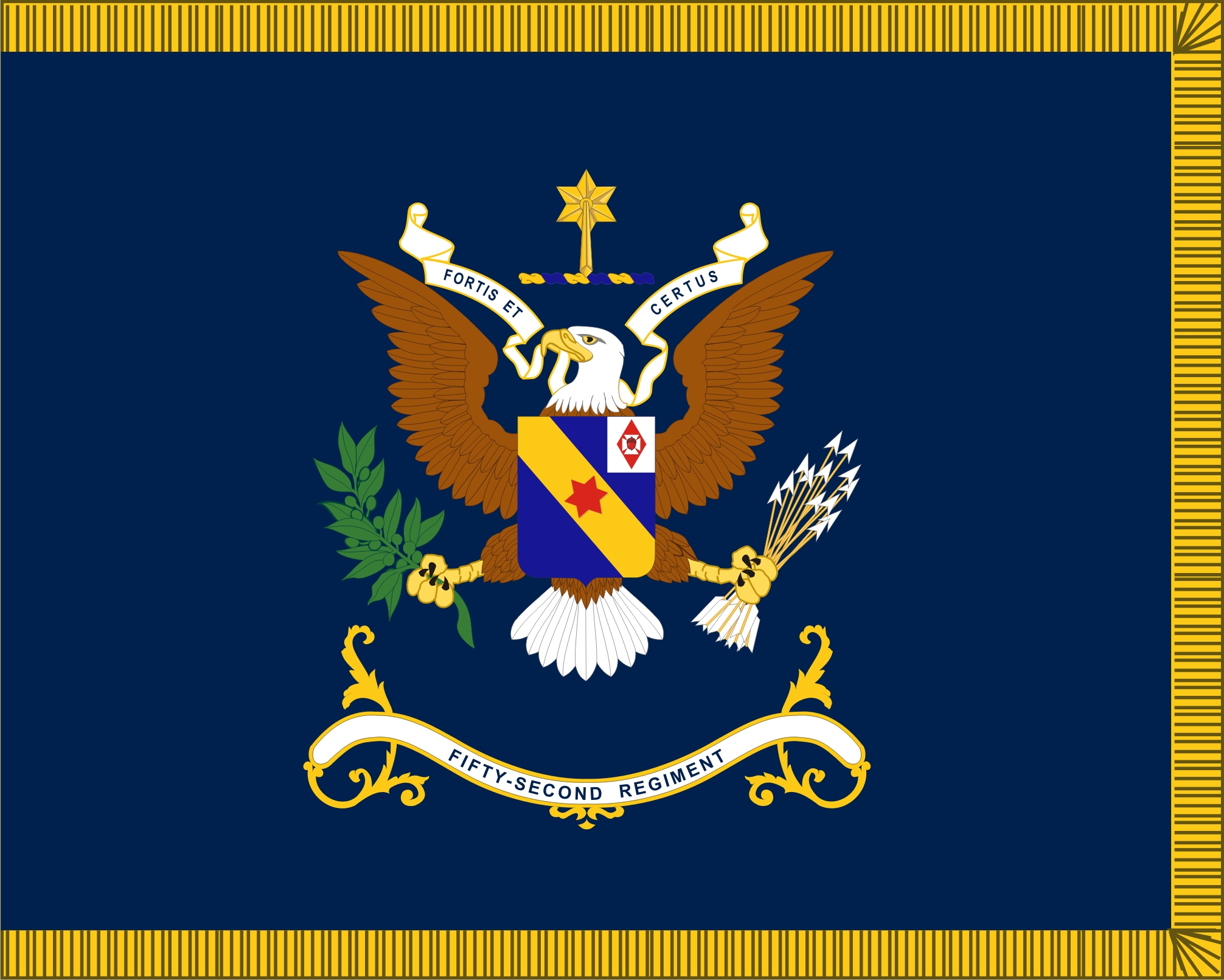 |
| US Army organisational colour |
In modern France however, only one flag is used in the colours and standards. This is a French Tricolour, the flag is doubles sided. On one side is the text "RÉPUBLIQUE FRANÇAISE"(French Republic) with the unit name below it. On the reverse is the text "HONNEUR ET PATRIE" (honour and fatherland) below which is the battle honours. Like the USA various situations and hounors may be displayed on streamers. The design is the same for cavalry and infantry regiments although the standards of a cavalry regiment are smaller.
 |
| French Army colour |
France like United Kingdom had a large empire and influence and this can be seen in the military flags of a number of countries, including many of France's former colonies and protectorates, who switch the French flag with their own.
The German Army on the other hand doesn't have regimental flags as such, Each unit would carry a ceremonial state flag, that is the German flag defaced with the national coat of arms of a black eagle on yellow shield. The boarder of which would have black red and yellow lacework and a gold fringe. Attached to the staff is a streamer with the unit badge and designation.
One of the most well known and oldest military regiments is the Swiss Guard responsible for the security of the Vatican. The colour of the Swiss Guard consists of four quarters divided by a white cross. In the first quarter are the arms of the current Pope. In the fourth quarter are the arms of Pope Julius II (The Warrior pope) The other quarters consist of horizontal stripes of blue, yellow and red reflecting the uniform. The arms of the regiment's commander is placed within a wreath on the colours of his canton (Swiss State).
 |
| Swiss Guard flag with the arms of Commandant Anrig, Popes Francis and Julius II |
In the modern Spanish armed forces each unit has a standard colour, this is a variant of the national flag but with the units name in black lettering around the national coat of arms. tassels and streamers may be attached which might have decorations and battle honours embroidered on them. This design replaced the Cross of Burgundy in 1843.
 |
| Colour of the Spanish Air Force Headquarters, The Streamers are those of the Order of Civil Merit, the Provincial Deputation of Pontevedra, Air Medal and Medal of the Army. |
Some regiments continue to use the old variant of a King's Colour, but these are only keeping alive a tradition and these flags have no official status. Smaller secondary standards and banners are also used, these do have official status, and known as second order colours. They are smaller flags than the standard colour, and can be any colour with any symbol, many still use the cross of burgundy.
Trooping the Colour
The 11th of June will see the Household Division perform the Queen's Birthday Parade, commonly called Trooping the Colour on Horse Guards Parade in London. The main part of the parade is a ceremony called trooping the colour, this is when the ensign (junior officer who carries the flag) along with his escort march with the colour through the ranks, so that the guards can all see it. This ceremony was practiced almost daily in camp and barracks in day of old when colours were carried into battle, the purpose behind it was so each soldier could familiarize himself with the flag's markings and easily identify it on a battlefield.
Similar ceremonies are performed in Australia, Canada, Malaysia and Singapore. To see the best of the five Foot Guard regiments perform it click
here, or if you just want a quick overview see the clip
Trooping the Colour is broadcast live at 1030(GMT) on BBC One and recorded and broadcast again at 1800 on BBC Two, unfortunately I don't know if it is broadcast on the BBC international channels like BBC America or BBC UKTV, but I would expect it to be on BBC World News.


_-_geograph.org.uk_-_1449041.jpg)
.jpg)










+Regiment+(french+Army).jpg)



